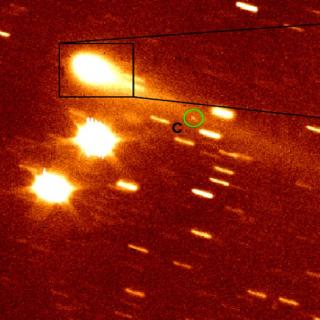Bibcode
Rodríguez Rodríguez, Javier; Díez Alonso, E.; Iglesias Álvarez, Santiago; Pérez Fernández, Saúl; Licandro, Javier; Alarcon, Miguel R.; Serra-Ricart, Miquel; Pinilla-Alonso, Noemi; Fernández, Susana del Carmen; de Cos Juez, Francisco Javier
Referencia bibliográfica
Monthly Notices of the Royal Astronomical Society
Fecha de publicación:
1
2024
Número de citas
2
Número de citas referidas
2
Descripción
We present 24 new dense light curves of the near-Earth asteroids (3103) Eger, (161989) Cacus, (2100) Ra-Shalom, and (12711) Tukmit, obtained with the Instituto Astrofísico Canarias 80 and Telescopio Abierto Remoto 2 telescopes at the Teide Observatory (Tenerife, Spain) during 2021 and 2022, in the framework of projects visible NEAs observations survey and NEO Rapid Observation, Characterization and Key Simulations. The shape models and rotation state parameters (P, λ, β) were computed by applying the light curve inversion method to the new data altogether with the archival data. For (3013) Eger and (161989) Cacus, our shape models and rotation state parameters agree with previous works, though they have smaller uncertainties. For (2100) Ra-Shalom, our results also agree with previous studies. Still, we find that a Yarkovsky-O'Keefe-Radzievskii-Paddack acceleration of υ = (0.223 ± 0.237) × 10-8 rad d-2 slightly improves the fit of the light curves, suggesting that (2100) Ra-Shalom could be affected by this acceleration. We also present for the first time a shape model for (12711) Tukmit, along with its rotation state parameters (P = 3.484900 ± 0.000031 h, λ = 27° ± 8°, β = 9° ± 15°).
Proyectos relacionados

Pequeños Cuerpos del Sistema Solar
Este Proyecto estudia las propiedades físicas y composicionales de los llamados pequeños cuerpos del Sistema Solar, que incluyen asteroides, objetos helados y cometas. Entre los grupos de mayor interés destacan los objetos trans-neptunianos (TNOs), incluyendo los objetos más lejanos detectados hasta la fecha (Extreme-TNOs o ETNOs); los cometas, y
Julia de
León Cruz